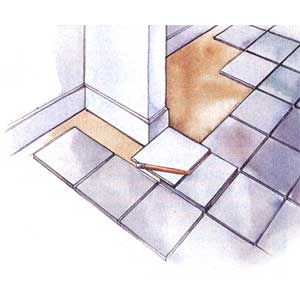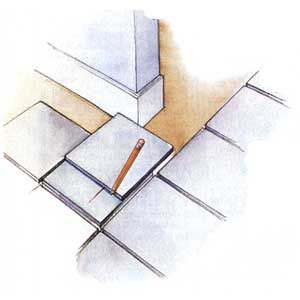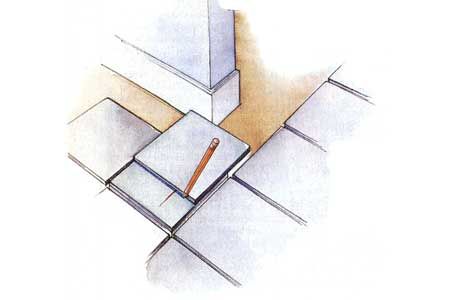Tiling in corners is a skill that any do-it-yourself (DIY) enthusiast should know. It can make or break the look of your tiled surface, whether it’s a floor, wall, or countertop. This guide will tell you how to achieve perfect corner tiles, from understanding the challenges to mastering advanced techniques.
Tools and Materials Needed for Tiling in Corners
Before you begin your corner tiling project, gather the right tools and materials. Here’s everything you’ll need.
Adhesives and Grouts
Choose a high-quality tile adhesive suitable for your tile type and installation location. A flexible adhesive is often recommended for corners to accommodate slight movements. Select a grout that matches or complements your tile color. For areas prone to moisture, consider using an epoxy grout for better water resistance.
Cutting Tools
For precise cuts around corners, you’ll need reliable cutting tools. A wet saw is ideal for making straight cuts and can handle most tile materials. For more intricate cuts or notches, consider using a tile nipper or a manual score-and-snap cutter. An angle grinder with a diamond blade can be useful for small adjustments or creating beveled edges.
Measuring Instruments
Accurate measurements are foundational for corner tiling. Equip yourself with a tape measure, a carpenter’s square, and a level. A laser level is good for checking that your tiles are perfectly aligned across multiple surfaces. Don’t forget a pencil or felt-tip marker for marking your tiles.
Preparing the Corner Area for Tiling
Start by cleaning the corner thoroughly and removing any dust, debris, or old adhesive. Check for any unevenness in the surface and use a leveling compound if necessary to create a flat base.
If you’re tiling over drywall in a wet area, apply a waterproof membrane to protect the underlying structure. For existing tiled surfaces, roughen them up with sandpaper to improve adhesion. Always prime the surface according to the adhesive manufacturer’s instructions to achieve a strong bond.
Using the Direct-Marking Technique to Tile in Corners
Professional tilers often use a direct marking technique to achieve precise cuts for corner tiles. This eliminates measuring errors and works well for various tile types, including ceramic, vinyl, and laminate. Here’s how you can follow this technique.
Step 1: Marking the First Cut Line
To begin, place the tile you need to cut on top of the last full tile closest to the corner. Make sure its edges are perfectly aligned with the tile below. Next, take another full tile and position it against the corner, overlapping the tile you plan to cut. Use a felt-tip pen or pencil to draw a line along the edge of the top tile onto the middle tile. This marks your first cut line.

Step 2: Marking the Second Cut Line
After marking the first line, move the top two tiles to the other side of the corner. Repeat the process to mark the second cut line on the middle tile. The area outlined by these two intersecting lines represents the portion of the tile that needs to be removed to fit the corner perfectly.

Cutting Tiles for Perfect Corner Fits
Once you’ve marked your tiles, it’s time to make the cuts. The method you choose will depend on the type of tile and the complexity of the cut.
- Manual tile cutting methods: Manual cutting methods can be effective for simpler cuts or when working with softer tiles. A score-and-snap cutter works well for straight cuts on ceramic tiles. For more intricate cuts or notches, use tile nippers to carefully remove small pieces until you achieve the desired shape. Smooth any rough edges with a rubbing stone.
- Using a wet saw: A wet saw is the most efficient tool for making straight cuts on ceramic or porcelain tiles. It provides a clean, precise cut and helps prevent chipping. When using a wet saw, always wear safety goggles and follow the manufacturer’s instructions. Make your cuts slowly and steadily for the best results.
Installation Techniques for Different Corner Types
Corner tiling techniques vary depending on whether you’re working with an inside or outside corner. Each type requires a specific approach to achieve a professional finish.
- Inside corners: Inside corners require careful attention to maintain consistent grout lines. Start by tiling one wall, leaving a small gap at the corner for expansion. Then, when tiling the adjacent wall, butt the tiles against the first wall, checking that they’re level and plumb. Use spacers to maintain even grout lines.
- Outside corners: When tiling an outside corner, the goal is to create a clean, sharp edge. One popular method is to use bullnose tiles, which have a rounded edge designed for corners. Alternatively, you can miter the tiles at a 45-degree angle to create a seamless corner. For a more modern look, consider using metal edge trim to finish the corner.
Grouting and Finishing Corner Tiles
Grouting and finishing preserve the appearance and durability of your tiled corners. The choice between grout and caulk depends on the specific corner type and location.
Choosing Between Grout or Caulk
Generally, inside corners should be caulked rather than grouted. This allows for slight movement and prevents cracking. Use a silicone caulk that matches your grout color for a seamless look. Outside corners and joints between different planes (like where a wall meets a floor) should be grouted for a more rigid finish.
Applying Grout in Corners
When grouting corners, use a rubber float to press the grout firmly into the joints. Work diagonally across the tiles to achieve even coverage. Be careful not to overfill the joints, as this can lead to cracking. After the grout has set slightly, use a damp sponge to clean excess grout from the tile surfaces.
Caulking Techniques for Corners
For caulked corners, start by applying masking tape on either side of the joint to create clean lines. Cut the caulk tube nozzle at a 45-degree angle and apply the caulk in a smooth, continuous bead. Use a caulk smoothing tool or your finger dipped in soapy water to create a neat finish. Remove the masking tape immediately after smoothing the caulk.
Troubleshooting Common Corner Tiling Issues
Even with careful planning and execution, you may encounter some challenges when tiling corners. Here are some common issues and solutions:
- Chipped tile edges: Use a tile file or sandpaper to smooth out minor chips, or replace severely damaged tiles.
- Cracked grout: Use a flexible grout additive in high-stress areas to prevent cracking.
- Gaps in corners: Fill small gaps with color-matched caulk instead of grout for a more flexible finish.
- Lippage: Check that tiles are level as you lay them, using a level and tile leveling system if necessary.
- Uneven corners: Use a corner trowel to apply extra adhesive and level out slight irregularities.
Maintenance and Care for Corner Tiles
Clean tiles and grout lines regularly with a pH-neutral cleaner to prevent dirt buildup. Avoid harsh chemicals that can damage grout or tile sealants. Reseal grout lines annually in high-moisture areas to prevent water penetration and mold growth.
Inspect corner tiles periodically for signs of cracking or loosening. Address any issues promptly to prevent water damage to the underlying structure. If you notice any damaged tiles, replace them as soon as possible to maintain the integrity of the tiled surface.
Advanced Corner Tiling Designs and Patterns
Once you’ve mastered basic corner tiling techniques, you can explore more advanced designs to add visual interest to your space. Consider these ideas:
- 3D effects: Use textured tiles or create a raised pattern in corners for added depth.
- Contrasting colors: Use a different colored tile for corner accents to create a striking visual effect.
- Diagonal patterns: Lay tiles at a 45-degree angle to add dynamic interest to corner areas.
- Mixed materials: Combine different tile materials or sizes for a unique corner feature.
- Mosaic accents: Use small mosaic tiles to create a decorative border around corners.

